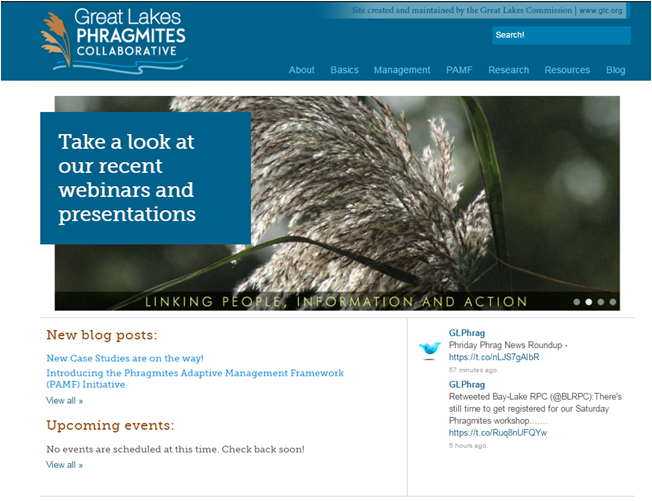May 20, 2016
Heather Braun, Katherine Hollins (Great Lakes Commission)

The GLPC is more than just a website. The GLPC provides the structure needed to engage stakeholders in a way that will align actions across the region.
A new paper was recently published showcasing the use of the collective impact framework to guide the Great Lakes Phragmites Collaborative (GLPC).
The GLPC, established in 2012, is a regional-scale partnership established to improve collaboration among stakeholders, and increase the effectiveness of non-native Phragmites management and research. Organizing diverse stakeholders engaged in Phragmites management across such a broad region is a challenge, and a novel approach was necessary to help establish a shared vision, align actions and resources, reduce redundancies, and support communication among the many agencies and individuals working on Phragmites in the Great Lakes.
To address this need, the GLPC embraced a method of collaboration called collective impact, which is defined as “the commitment of a group of actors from different sectors to a common agenda for solving a specific social problem, using a structured form of collaboration” (Kania and Kramer 2011). It is the structure of collective impact that provides the framework to maximize collaboration by identifying a common vision and establishing a path to achieve that vision. The GLPC has seen success implementing collective impact, and was recognized by the Great Lakes Interagency Task Force (2014) as a model for other collaboratives in the region. As the GLPC continues its work with stakeholders, the collective impact approach will support the alignment of management and research efforts across the region to effectively protect wetlands from the negative impacts of non-native Phragmites.
The collective impact approach is described in more detail in a paper recently published in the journal, Biological Invasions: Applying the collective impact approach to address non-native species: a case study of the Great Lakes Phragmites Collaborative. The purpose of this paper is to:
-

Collective impact has been more traditionally used for intractable social issues, such as career readiness.
summarize the core principles of collective impact as a model for addressing complex natural resource issues
- report on the GLPC’s application of collective impact principles for management and research on non-native Phragmites in the Great Lakes region
- present recommendations for evaluating and establishing collective impact collaboratives for other species or subject areas.

The authors discuss several partnership approaches and their appropriate uses
The manuscript provides insight on how the GLPC functions and a window into the future of the collaborative. It also allows others working on complex, large-scale, natural resource issues to use the guidelines outlined to consider whether collective impact may provide the structure they need to make progress.
You can read the abstract online, or contact Heather Braun if you would like a copy of the full text.
